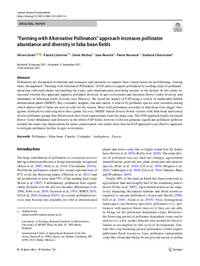“Farming with Alternative Pollinators” approach increases pollinator abundance and diversity in faba bean fields

Authors:
Pollinators are threatened worldwide and strategies and measures to support their conservation are proliferating. Among them, the approach “Farming with Alternative Pollinators” (FAP) aims to support pollinators by seeding strips of pollinator-attracting cultivated plants surrounding the crops, and simultaneously providing income to the farmer. In this study we assessed whether this approach supports pollinator diversity in agro-ecosystems and increases flower visitor diversity and abundance in faba bean fields in north-west Morocco. We tested the impact of FAP using a variety of marketable habitat enhancement plants (MHEP): flax, coriander, arugula, chia and canola. A total of 62 pollinator species were recorded, among which almost half of them are new records for the region. Most wild pollinators recorded in faba bean were digger bees (genus Anthophora) and long-horn bees (genus Eucera). MHEP shared diverse flower visitors with faba bean and hosted diverse pollinator groups that did not meet their food requirements from the main crop. The FAP approach highly increased flower visitor abundance and diversity in the whole FAP fields, however it did not generate significant pollinator spillover towards the main crop. Implications for insect conservation: our results show that the FAP approach is an effective approach to mitigate pollinator decline in agro-ecosystems.
